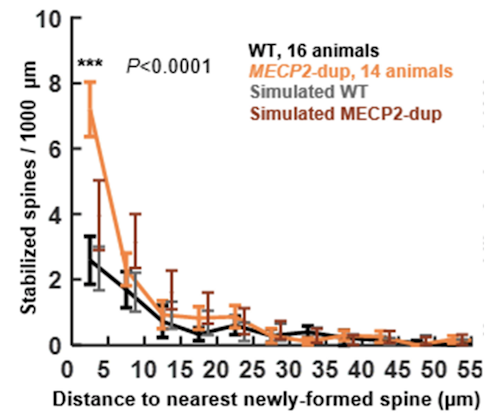Enhanced spontaneous turnover of dendritic spines has been observed in several autism mouse models, including the MECP2 duplication mouse model. In the current study, SFARI Investigators Stelios Smirnakis and Huda Zoghbi decided to assess dendritic spine structural plasticity in further detail in the MECP2 duplication mouse and to see whether motor training influences the dynamics. This work was supported in part by a SFARI Research Award.
Using in vivo two-photon imaging techniques, the researchers observed an increase in the stability of newly formed dendritic spines in the MECP2 duplication mouse compared to wildtype mice. Furthermore, they found that this increased spine stabilization in the mutant mice was mediated almost exclusively through excessive stabilization of spines that formed cooperatively within 10 mm of each other. Isolated spines that formed beyond this interspine distance were not excessively stabilized. This result was observed in both the motor and visual cortex.

Although newly formed dendritic spine clusters were more stable in MECP2 duplication mice, overall dendritic spine turnover was elevated, as has previously been reported. Thus, two different plasticity processes must be operating in the mutants: increased stabilization of clustered spines and increased overall spine turnover. Further work will be needed to parse out the molecular mechanisms underlying these observed structural remodeling changes.
In contrast to prior studies, the current study did not find any significant differences in spine formation, stabilization or clustering in mice trained on the rotarod compared to untrained animals within each genotype. While these results are surprising, the authors suggest that a weaker rotarod training paradigm may be the reason and that stronger training paradigms that result in repeated “overtraining” in a task are likely to be necessary to induce measurable increases in spine formation in the motor cortex.
In summary, further studies are needed to determine whether the observed increase in spine clusters in MECP2 duplication mice correlates with functional changes that might account for some of the phenotypes associated with MECP2 duplication syndrome and other autism spectrum disorders.
Reference(s)
Excessive formation and stabilization of dendritic spine clusters in the MECP2 duplication syndrome mouse model of autism.
Ash R.T., Park J., Suter B., Zoghbi H., Smirnakis S.


